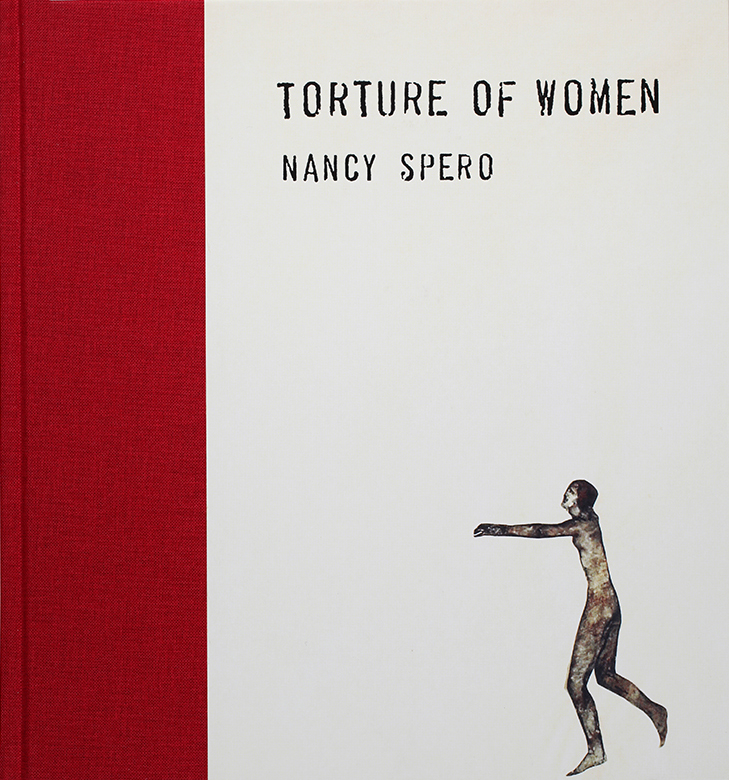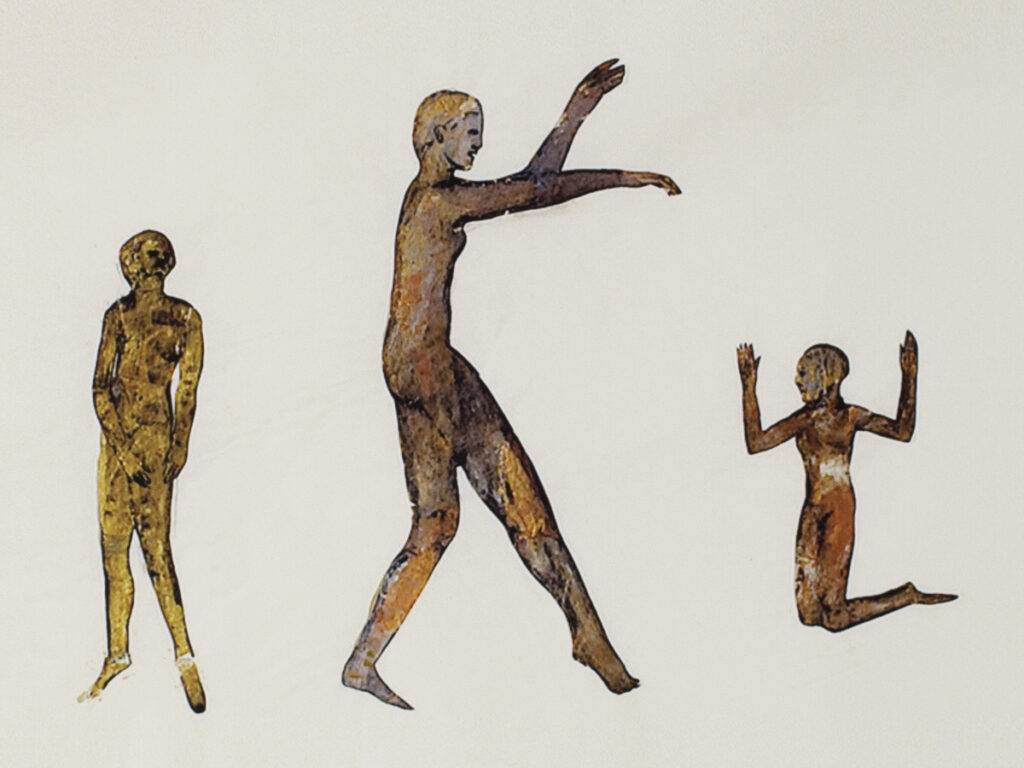Nancy Spero: Tongue, Torture and Free ReinCatherine de Zegher
affinities, 06/07/10
NANCY SPERO (1926–2009, born in Cleveland, Ohio) is regarded as a pioneer in feminist art whose work confronts social and political injustice with creative ingenuity. Galerie Lelong is currently exhibiting Nancy Spero: From Victimage to Liberation: Works from the 1980s & 1990s through February 16. Insights into the lineage of Spero’s work are abundant in Catherine de Zegher’s essay, excerpted below. Siglio’s publication of Torture of Women translates Spero’s epic 125 ft. work into nearly 100 pages of detail so that readers can experience this fierce and enduring contribution to contemporary art, to feminist thought and action, and to the continuing protest against torture, injustice, and the abuse of power outside of the exhibition space.
Published with permission of the author © 1998. Essay originally published in Nancy Spero, Ikon Gallery, Birmingham, UK.
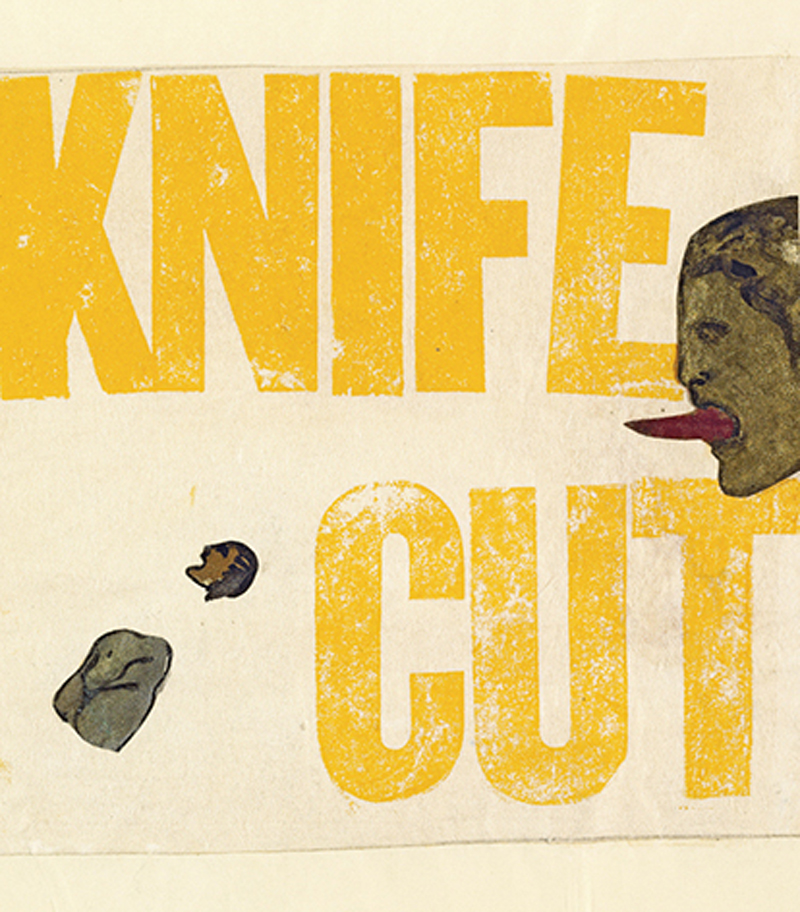
All images are details from Torture of Women by Nancy Spero, Siglio, 2010.
1969–1972: The Codex Artaud
These sentences are just a few from the numerous quotes that Spero was copying in her notebooks from the writings of the French poet Antonin Artaud.1 As if, having abandoned oil painting, she wanted to continue gesticulating and to painstakingly exercise, to articulate the joints of her fingers by transcribing and pen-pushing. First she used left handed writing—to parallel the poet’s unstable mental and physical condition, but also his marginalization—then a bulletin typewriter for more extended, still fractured excerpts. Like the brush, the pencil and typewriter endowed her hand with a voice. Meanwhile the pages of transcription enabled her to acknowledge Artaud’s resentment and violent response to suffering and exclusion. “Artaud screams and yells and rants and raves about his tongue being cut off, castrated. He has no voice, he’s silenced in a bourgeois society.”2 Her hands being her voice, for Spero to gesticulate while copying (the poems of a desperate and ill man) meant, on the one hand, the mimicry of muteness and difficulty in articulating (as a woman, as an artist, as a victim of arthritis), and on the other hand, the literal sign of the human capacity for word-making, for moving beyond the boundaries of her/his body into the external, sharable world.
Obstinately the artist “talked with her hands,” although she realized that, unlike any other state of consciousness (psychic, somatic, or perceptual), physical pain resists verbal objectification in language. Because bodily pain has no referential content—it is not of or for anything, and thus takes no object—it remains a difficult task to convey the experience of pain itself. The knowledge, however, that “whatever pain achieves, it achieves in part through its unsharability, and it ensures this unsharability through its resistance to language,”3 stimulated Spero even more to develop her sign language in order to record exactly the possible passage of pain into speech, into the public realm of communication. The tongue was her weapon. Though she felt “like a nonartist, a nonperson,” she was determined to practice the organs of speech, to act, and to confront language with its own limits, with what is in a sense a “nonlanguage” (as Gilles Deleuze defines it: “violence that does not speak, eroticism that remains unspoken”). However, like in “pornological” literature, “this talk can only be accomplished by an internal splitting of language: the imperative and descriptive function must transcend itself toward a higher function, the personal element turning by reflection upon itself into the impersonal.”4 Les Anges, Merde, Fuck you, Smoke Lick, Sperm Bombs, Helicopters, and Victims from the earlier War Series expressed her existential anger and mirrored back protest against an interior and exterior hostile world. Her night-dark Angels became Nightmare Demons to be exorcised from the body.
In the four years of working with Artaud’s writings Spero sensed: “his disapproval of what I was doing—a woman artist excerpting and fracturing his already fractured screams and pleas.”5 Using the typewritten quotes in tension/in relation with hand-printed hybrid images of paroxysmic bodies and free-floating heads with their tongues sticking out, The Codex Artaud retrieves collage techniques, that insert graphically or mechanically produced imagery. Pinned directly to the wall, the series consists of thirty-two horizontal or vertical scrolls of paper (approx. 52 cm high × 48 cm, 201 cm or 316 cm long). In an imperfect way, sheets of paper chosen carefully for their fragile and transparent qualities (reminiscent of Artaud’s description of pain as “le sentiment d’être en verre et brisable”/”the feeling of being made of glass, breakable”), are glued together to create Spero’s lengthy codex. Onto the pictorial surface disparate narrow strips of paper rhythmically carry along her typed arrangements of Artaud’s words as concrete poems. In fact, by taking up the copied fragmentary lines of Artaud—listed by Julia Kristeva as a radical author of a ‘feminine’ tradition—the artist not only introduces the potential for a “feminine writing,” but also joins the disruptive features of the “semiotic”6 to the cut-and-paste techniques of the collage. The figures considered as hieroglyphs, extensions of the texts, explode in an undefined space disengaging images and words from any ‘normal’ milieu.7 The scrolls as spaces of inscription unfold this extensive scatter of painted, cut out and collaged heads, tongues (defiant and phallic) and grotesque bodies (part human and animal or insect- and snake-like) next to the writhings/writings of drive and torment, like a story without a beginning, middle or end. In a multiplicity of viewing points, the beholder can start anywhere, and while reading, move in any direction according to her/his wish.
In a way the whole visual construct of dispersed textual and graphic elements, lacking any preordained coherence or fixedness, aspires for the “semiotic”: not as much for the nostalgic chaos of the inarticulate pre-linguistic but rather as demonstration of the language-destroying process of bodily pain. It indicates how “physical pain does not simply resist language but actively destroys it, bringing about an immediate reversion to a state anterior to language, to the sounds and cries a human being makes before language is learned…”8 Over the course of Spero’s many scrolls it becomes gradually apparent why torture and pain should so crucially entail, require even, this shattering of language. “Often, a state of consciousness rather than pain will, if deprived of its object, begin to approach the neighborhood of physical pain; conversely, when physical pain is transformed into an objectified state, it (or at least some of its aversiveness) is eliminated. A great deal, then, is at stake in the attempt to invent linguistic structures that will reach and accommodate this area of experience normally so inaccessible to language; the human attempt to reverse the de-objectifying work of pain by forcing pain itself into avenues of objectification is a project laden with practical and ethical consequence.”9
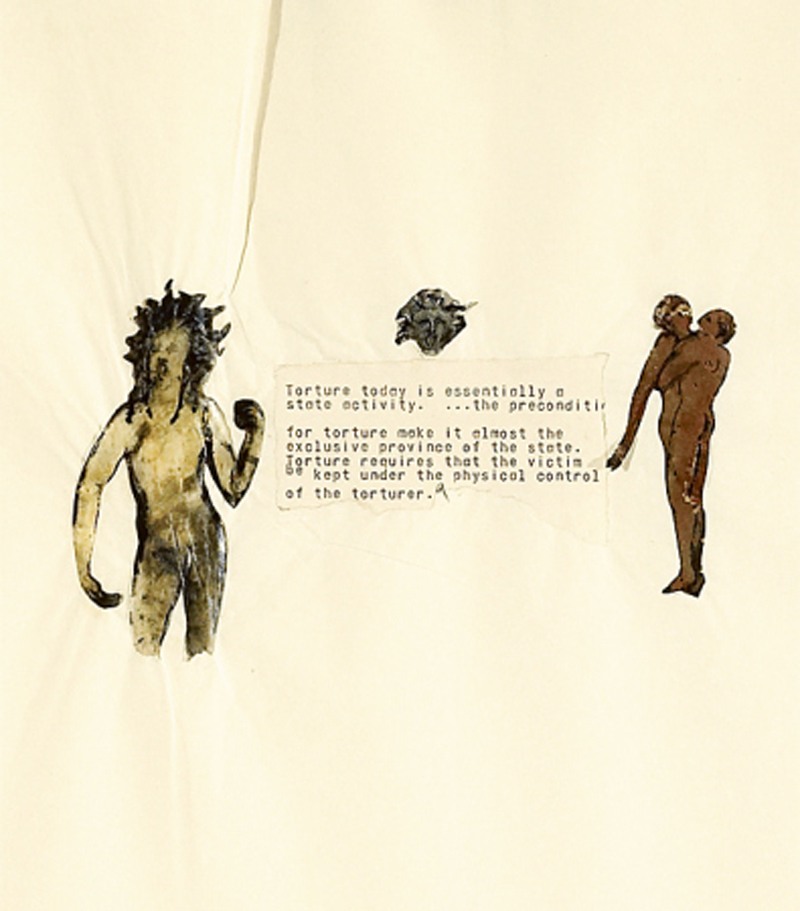
1976–1979: Notes in Time
Leaving spaces blank, brief typewritten descriptions of torture are collaged onto the long paper scrolls: revealing descriptions… not a narrative, not a fiction, but eyewitness accounts so horrifying as to be a hard to read…a report calling for a report. Yellow letters of a printers’ wood type alphabet head the first of fourteen panels (51 × 3180 cm overall) of Torture of Women (1974–1976): ‘Explicit Explanation’. Initially Torture of Women was planned as part one of Notes in Time, which consisted of twenty-four panels (51 × 6398 cm overall) and resulted from several years of stockpiling records, images and quotations. Again, in a solitary act, Spero has been transcribing information from verbal documents gathered by Amnesty International during the dictatorships in Chile, Argentina, and El Salvador. Since she intended “an art that depersonalizes the subjective portrayal of the individual,”18 she moved away from Artaud’s investigations of suffering mediated by art—it seemed to her “that because artists so successfully express suffering, they may themselves collectively come to be thought of as the most authentic class of sufferers, and thus may inadvertently appropriate concern away from others in radical need of assistance”19—to the case histories of tortured women political prisoners in actual reports. Paralleling this development, Spero’s increasing use of the mechanically reproduced word- and-picture-printing could be considered as an attempt to depersonalize hand-writing and deskill painting altogether. At once, the medium of printing allowed her to overcome the stiffening torture in her hands, paradoxically confronting personal implication with the specific accounts of physical and mental abuse that she was seeking to represent. Complying with the strategy of Amnesty International, the artist aimed to communicate the reality of physical pain to those who are not themselves in pain, in order to bring about cessation or torture. The way to approach these collages, which include officially published, though very private descriptions of utter cruelty, is as a contribution to the passage of physical pain into the public realm of shared discourse. Embedded in this aim is the assumption that the verbalization of pain appeals for the collective task of diminishing, and eventually eliminating pain.20
Inevitably, this indicates how the problem of torture is inextricably linked to the problem of power, for empowerment in its legitimate as in its fraudulent forms is always based on a transformation of body into voice. The negative use of the ‘language of agency’ (in other words, the verbal strategies revolving around the verbal sign of the weapon) achieves the full extremity of its sadistic potential in torture. To further quote Elaine Scarry: “Torture inflicts bodily pain that is itself language-destroying, but torture mimes (objectifies in the external environment) this language-destroying capacity in its interrogation, the purpose of which is not to elicit needed information but visibly to deconstruct the prisoner’s voice. (…) The prolonged interrogation also graphically objectifies the step-by-step backward movement along the path by which language comes into being and which is here being reversed or uncreated or deconstructed.”21 Since the voice is a final source of self-extension beyond the boundaries of the body in a much larger space, inflicted pain and blanks in speech contract the universe down to the immediate vicinity of the body or swell the body to fill the whole universe. World, self, and tongue are lost through the annihilating power of pain. It is the prisoner’s steadily shrinking ground that wins for the torturer his/her magnifying sense of territory: “the absence of pain is a presence of world; the presence of pain is the absence of world.”22 Across this set of inversions, illusion of power. (It is, of course, precisely because the reality of that fictionalized power is so highly contestable, the regime so unstable, that torture is being used.23
Clearly, Spero’s series of Notes in Time demonstrates that the ‘language of agency’ has on the one hand a beneficent potential and on the other hand a radically sadistic one. The two uses are not simply distinct but mutually exclusive.24 Her work enables the reader to unravel this collapse of making into unmaking which occurs because of the referential instability of the verbal sign: its alteration as weapon, tool, or artifact. “Violence in language is a violation. It is a destroyer of society, a breakdown. Artaud as pariah, and the women who have been tortured each give testament of this breakdown. There are great differences in the two themes yet they are both powerful indictments of society”25 Increasingly, it becomes intelligible how Spero is exposing the political and perceptual consequences of inexpressibility. Elaborating Notes in Time the artist added more depictions of ‘lovers’ (small versions derived from her former Paris Black Paintings) and athletic, erotic, dancing women, in a diverse borrowing from fantastic or mythological sources to art historical references (Egyptian hieroglyphs, Sumerian wall paintings, aboriginal art, Greek vase paintings, Roman sculpture, medieval manuscripts, etc.), to current and popular magazines. It is within the frame of an already existing array of artifacts representing women that her introduction of new images takes place. Within this frame, as a counteracting move, she decided to make “woman the protagonist”: independent, plain-spoken, uninhibited, unbridled, sensual and liberated, even if she knew this wasn’t really the case. “Parler-femme, speaking (as) woman,” looking for “the blanks in discourse” (Irigaray), and claiming that women need a language, it is Spero’s aim to think woman-as-subject in the symbolic, which conditions the coming-to-be of woman-as-subject in the social. And it is, inversely, women’s affirmation as social subjects that allows them to rethink subjectively in language.26 As images of agency, images of physical autonomy, and sometimes of obscenity, her triumphant female figures could stand up against the weight of the accounts which speak only of women’s victimage.27
Nevertheless, besides the combination of death instincts in the unconscious with life instincts, Eros and Thanatos, what is the meaning of the encounter of violence and sexuality, pain and pleasure, in such abundant textual and visual language as Spero’s? How are we to account for the violent (imperative and descriptive) language linked with eroticism? Perhaps, since her selection of images consists mainly of an idealized range of procreative and exalted bodies of women, its contemplation may also occur in a mystical or idealistic frame of mind—a frame in which masochism seeks historical and cultural confirmation.28 Thus fashioned as powerful the female images have a terrific/terrifying effect as well, generating on the one hand, a collision with the demonstrative use of language related to the omnipotence of its sadistic author, and on the other hand, a correspondence to (or a pact with) the masochist’s desire for submission and cooperation in his/her educational undertaking. For if “the masochistic hero appears to be educated and fashioned by the authoritarian woman[man], it is basically he [she] who forms her [him], dresses her [him] for the part and prompts the harsh words she [he] addresses to him [her]. It is the victim who speaks through the mouth of his [her] torturer, without sparing [her]himself.”29 Further reading of Deleuze, who endorses Georges Bataille, reveals that, “paradoxically, only the victim can describe torture; the torturer necessarily uses the hypocritical language of established order and power” and keeps silent.30 Lifting into the realm of the intelligible by the whole technique of dialectical reversal and disguise, Spero’s working method implies displacements in the allocation of roles and discourse. The artist mentions the torturers’ silence and cruel attitude, but uses them to make self-contradictory statements to other people. Simultaneously, she is aware that “there is a certain natural repugnance in a healthy person’s recognition of other’s pain, deformity—either mental or physical—an intolerance by the observer of the victim, the sufferer.”31 Overstepping masochistic bondage and humiliation, Spero’s juxtaposition of celebratory figures next to the printed abominable writings conveys the potential of expressibility, as Scarry describes it: “To witness the moment when pain causes a reversion to the pre-language of cries and groans is to witness the deconstruction of language; but conversely, to be present when a person moves up out of that pre-language and projects the facts of sentience into speech is almost to have been permitted to be present at the birth, or rebirth, of language itself.” 32
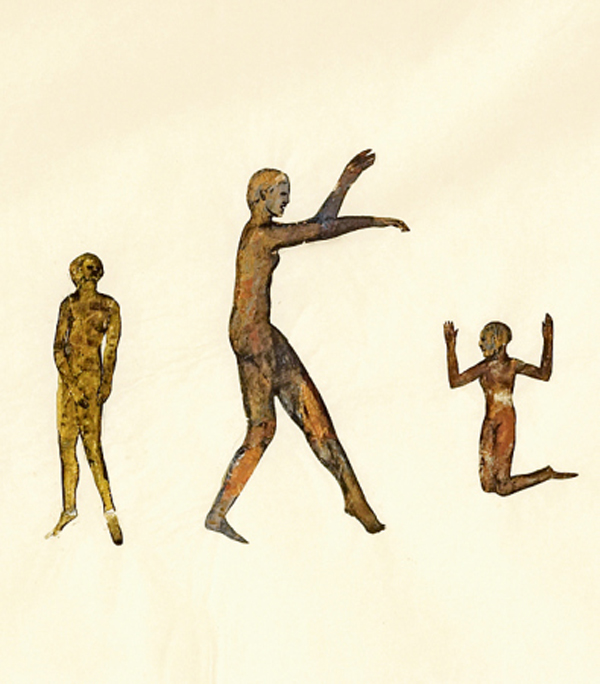
footnotes
- In a conversation Yve-Alain Bois mentioned the author that Henri Matisse used to copy in calligraphy pages of Mille et une nuits, Don Quichote, etc… probably just to practice the flexibility of his fingers when he was not painting. At the end of his life he used collage techniques in response to his physical condition.
- Nancy Spero in the interview with Jo Anna Isaak in Nancy Spero (London: Phaidon Press), 1996, p. 10.
- Elaine Scarry, The Body in Pain: The Making and Unmaking of the World (Oxford: Oxford University Press), 1985, p. 4-5.
- Gilles Deleuze, Masochism. Coldness and Cruelty (New York: Zone Books), 1991, p. 22-23. In his study Deleuze regards the novels of Leopold von Sacher-Masoch and also of the Marquis de Sade as “pornological literature.”
- Statement of the artist, 10/9/1996.
- For Kristeva the “semiotic” refers to the actual organization, or disposition, within the body, of instinctual drives as they affect language and its practice, in dialectical conflict with the “symbolic.”
- Nancy Spero in the interview with Barbara Flynn, ibid., p. 1.
- Elaine Scarry, ibid., p. 4.
- Elaine Scarry, ibid., p. 5–6.
- Elaine Scarry, ibid., p. 11.
- Elaine Scarry, ibid., p. 27–59.
- Elaine Scarry, ibid., p. 20.
- Elaine Scarry, ibid., p. 37.
- Elaine Scarry, ibid., p. 27.
- Elaine Scarry, ibid., p. 13.
- Nancy Spero in the interview by Barbara Flynn, ibid., p. 4
- It is Spero’s joining women artist’s action and discussion groups, such as WAR (Women Artists in Revolution) in 1969, and the Ad Hoc committee of women artists, and AIR Gallery, an all-women’s co-operative gallery founded in 1972, that in a way made it possible for her to occupy a position as a woman artist.
- Jo Anna Isaak in the interview with Nancy Spero, ibid., pg. 24.
- Gilles Deleuze, ibid., pg. 21.
- Gilles Deleuze, ibid., p. 22: “The ascent from the human body to the work of art and from the work of art to the Idea must take place under the shadow of the whip.”
- Gilles Deleuze, ibid., p. 17.
- Statement of the artist, 10/9/1996.
- Elaine Scarry, ibid., p. 6.
see also
✼ natalie’s upstate weather report:
September 23, 2022 — Relentlessly stormy with brief bouts of sunshine as the melancholy of fall sets in. We’re all about the dummies here (and proofs), preparing to send off HC’s I Will Keep My Soul to press. Meanwhile, our publisher LP (who will not be bullied) is continuing testimony on zoom at a court in Lithuania (wish her luck!). And like a rocket with a countdown, we’ve launched this website! Thank you, TG & JG of ES!
[...]